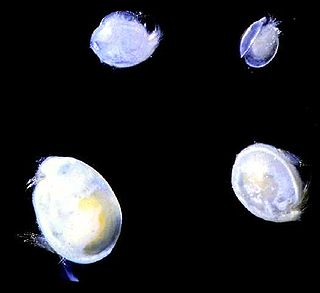
Mealybugs are insects in the family Pseudococcidae, unarmored scale insects found in moist, warm habitats. Of the more than 2,000 described species, many are considered pests as they feed on plant juices of greenhouse plants, house plants and subtropical trees and also act as a vector for several plant diseases. Some ants live in symbiotic relationships with them, protecting them from predators and feeding off the honeydew which they excrete.

The Pentastomida are an enigmatic group of parasitic arthropods commonly known as tongue worms due to the resemblance of the species of the genus Linguatula to a vertebrate tongue; molecular studies point to them being highly-derived crustaceans.

Karl Moriz Diesing was an Austrian naturalist and zoologist, specializing in the study of helminthology.
Atelocerata is a proposed clade of arthropods that includes Hexapoda and Myriapoda, but excludes Crustacea and Chelicerata. The name is currently used interchangeably with Tracheata. or Uniramia sensu stricto. It is an extensive division of arthropods comprising all those that breathe by tracheae, as distinguished from Crustacea, which breathe by means of gills.

Arachnomorpha is a proposed subdivision or clade of Arthropoda, comprising the group formed by the trilobites and their close relatives (Artiopoda), Megacheira and chelicerates. Under this proposed classification scheme, Arachnomorpha is considered the sister group to Mandibulata.

Pancrustacea is the clade that comprises all crustaceans and all hexapods. This grouping is contrary to the Atelocerata hypothesis, in which Hexapoda and Myriapoda are sister taxa, and Crustacea are only more distantly related. As of 2010, the Pancrustacea taxon was considered well accepted, with most studies recovering Hexapoda within Crustacea. The clade has also been called Tetraconata, referring to having four cone cells in the ommatidia. The term "Tetraconata" is preferred by some scientists in order to avoid confusion with the use of "pan-" to indicate a clade that includes a crown group and all of its stem group representatives.

The brindled beauty is a Palearctic moth belonging to the family Geometridae.
Richard Heymons was a German zoologist and entomologist.

Linguatula serrata is a species of cosmopolitan zoonotic parasite, belonging to the tongueworm order Pentastomida. They are wormlike parasites of the respiratory systems of vertebrates. They live in the nasopharyngeal region of mammals. Cats, dogs, foxes, and other carnivores are normal hosts of this parasite. Apparently, almost any mammal is a potential intermediate host.

Lycia is a genus of moths in the family Geometridae.

Armillifer is a genus of tongue worms in the subclass Pentastomida. It contains the following species:

Armillifer armillatus is a species of tongue worm in the subclass Pentastomida occurring in tropical Africa. Its typical definitive hosts are pythons, such as the African rock python, while rodents are presumed to act as intermediate hosts. Humans may become accidentally infected by the eggs particularly if consuming infected snakes. Ingested eggs develop into nymphs that invade different visceral organs causing a disease called porocephalosis. Humans have been infected by eating undercooked snake meat or through direct contact. Most human infections are asymptomatic, some are debilitating, or rarely even lethal. Diagnoses of infection has usually been done by accident, and almost all patients did not require treatment.
Reighardia sternae, also known as the larid pentastome, is a small internal parasitic crustacean. It is the only Pentastomida species to use gulls and terns as hosts, living in the body cavity and air sacs.

Armillifer grandis is a species of tongue worm in the subclass Pentastomida found in tropical Central and West Africa. Its typical definitive hosts are viperid snakes, while rodents are presumed to act as intermediate hosts. Humans may become accidentally infected by the eggs, particularly if consuming infected snakes. Ingested eggs develop into nymphs that invade different visceral organs, causing a disease that is often called porocephalosis. Most human infections are asymptomatic, although some cases are debilitating and even lethal. Abdominal infections are more widespread, but typically undiagnosed, while ocular manifestations are rare and may cause blindness.

Oligostraca is a superclass of crustaceans. It consists of the following classes:
Paraperipatus is a genus of velvet worms in the family Peripatopsidae. This genus exhibits matrotrophic viviparity, that is, mothers in this genus retain eggs in their uteri and supply nourishment to their embryos, but without any placenta. Species in this genus are found in New Guinea and the surrounding islands, including the Maluku achipelago.
Raillietiella teagueselfi is a species of parasitic crustacean. Raillietiella in general are found in tropical and sub-tropical regions and adults affect the lungs of reptiles and amphibians.

Porocephalidae is a family of crustaceans belonging to the order Porocephalida.
Reighardiidae is a family of crustaceans belonging to the subclass Pentastomida. It is the only family in the monotypic order Reighardiida.

Ichthyostraca is a class of parasitic crustaceans. It is composed of two subclasses; Pentastomida and Branchiura. They mainly parasitize various vertebrates and feed on their blood or mucus.












